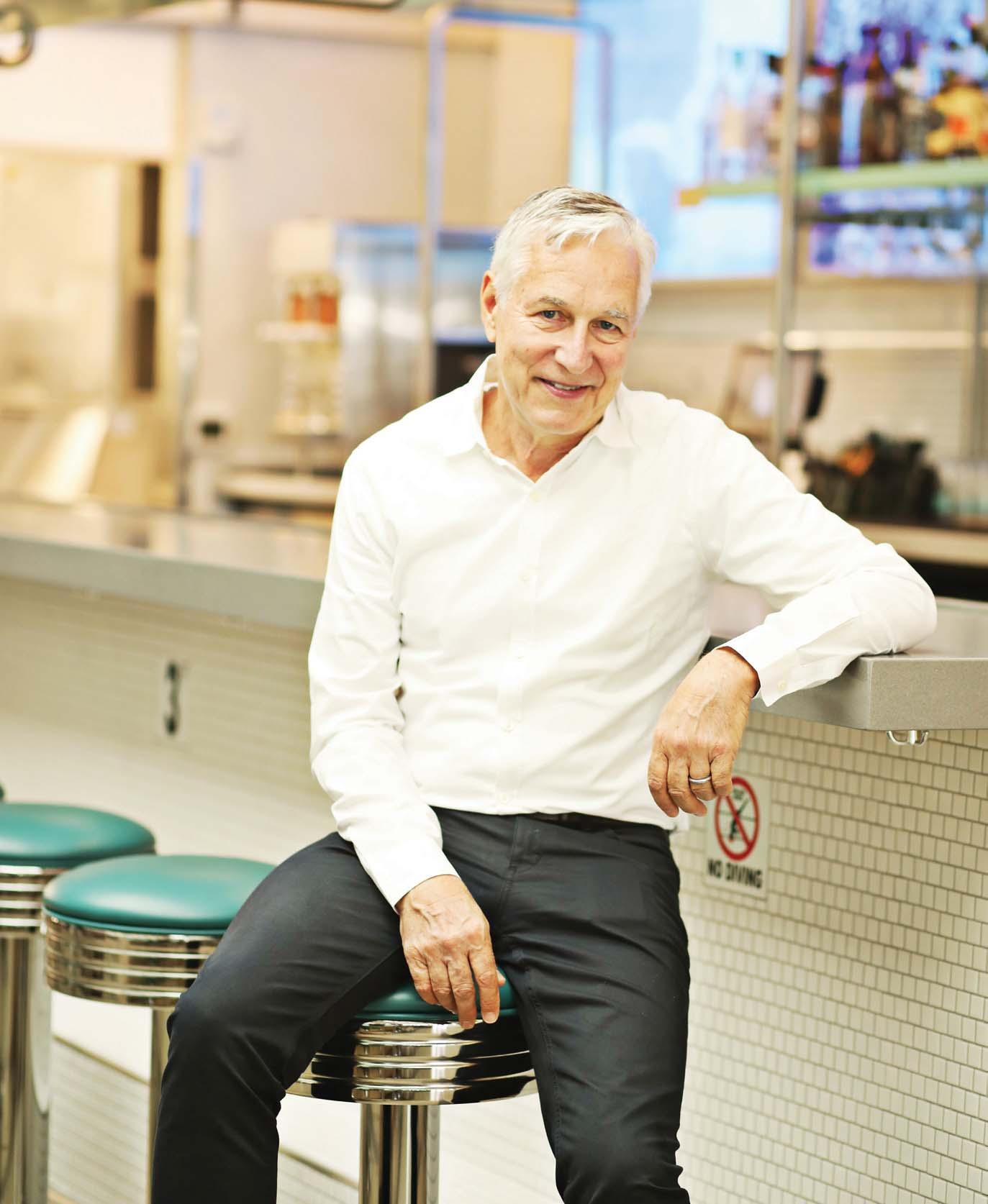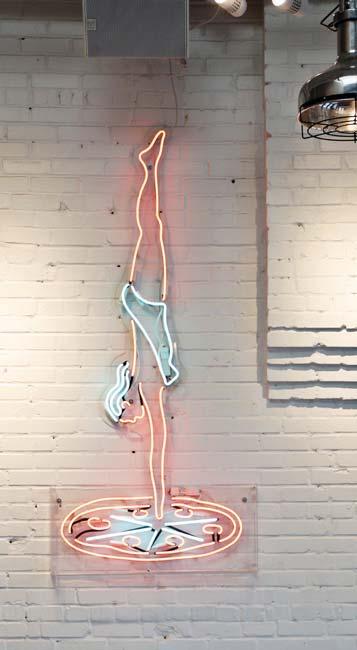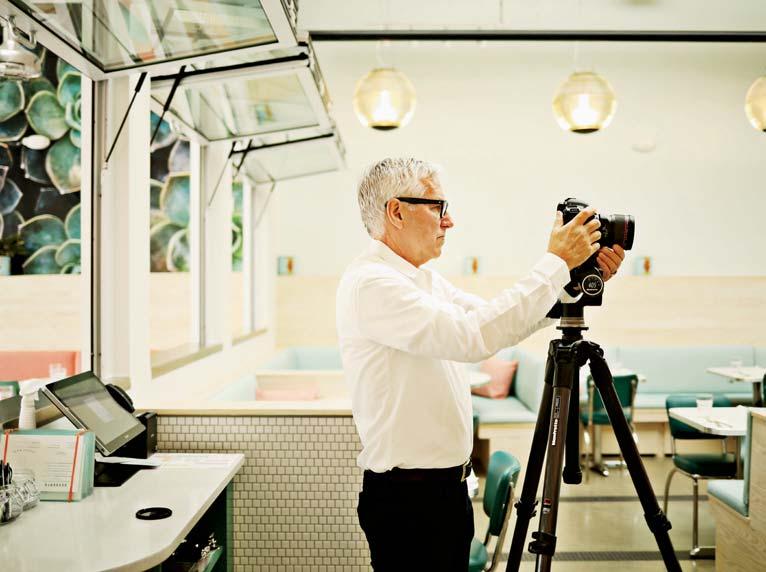
12 minute read
Dining by Design
Architect and interior designer Louis Cherry at Poole’side Pies.

Advertisement
A seasoned architect and interior designer shares his perspective on creating ambience for Raleigh’s restaurant scene
by LOUIS CHERRY photography by JULI LEONARD
Ihave a longstanding love of and fascination with restaurants. I’m keenly aware of what they add to how I experience a place, both when I’m away and when I’m home. My memories of travel are almost always linked to dining: Chez Panisse in Berkeley, Di
Fara Pizza in Brooklyn, Catbird Seat in
Nashville, FIG in Charleston—all powerful memories, shaped by food. When I seek out these special experiences for food and wine, I always take photos and careful notes. I observe what makes certain restaurants special and enjoyable—not just the presentation and taste of the food, but the seating and tables, the views and organization of space, the sounds and colors. What could be more memorable, for example, than dining on an outdoor patio, enjoying views of the Tuscan hills with
Umberto, La Chiusa’s owner, so pleased that I had brought my mother to Italy to dine with him? Most places—neighborhoods, cities, regions, countries—are known in large part by the food and how they serve it.
Shrimp and grits in Charleston, beef brisket in Austin, Cacio e Pepe pasta in Rome; all are inextricably linked to their locales. Think of how many times you have told someone you were going somewhere for the first time, and they responded with some version of, “You have to go to this restaurant!” I recall dining at my grandparent’s farm in Greenville, North Carolina. There, the deep connection to Southern life was reflected in what was served. My grandmother, Lilly, would chase down a chicken and wring its neck, then we would be soon eating it for Sunday supper—farm to table in ninety minutes. On a trip to the Emilia Romagna region in Italy some years ago, I realized that my grandparents’ ham-curing house was pretty much the same as those that were used to make Prosciutto di Parma. That was my first major revelation about the ways that North Carolina food and culture were connected to “foreign” food culture, well before Southern food was recognized as having a real place in the culinary universe. As the Triangle and many other areas in North Carolina have become denser, more urban and better connected to other parts of the nation and the world, we have seen a tremendous evolution in the local dining scene. As a former restaurant owner, current restaurant designer and always avid diner, I’ve experienced Triangle restaurants from several perspectives over the past twenty-some years. Here are a few examples.
LEARNING BY DOING
I opened my restaurant, Enoteca Vin, on Glenwood Avenue in 1998 with my business partner, Chrish Peele. Vin was a casual, fine dining restaurant, with an extensive wine list and a menu that featured small plates, charcuterie, artisan cheeses and locally sourced ingredients. At the time, the idea of serving top-quality cuisine in a very casual setting was new to the Triangle, where fine dining establishments mostly featured white tablecloths and formal service. We wanted patrons to feel welcome no matter whether they were in a tuxedo or jeans, and to always feel that they were in a special place. Our 1930s French advertising art, which were large-scale original Parisian lithographs that I sourced through a Chicago gallery, announced hospitality and playfulness, evoking another time and place in our little spot on Glenwood South before there was much else there. Our aim was to make people feel welcome and comfortable there, but also to feel like they were having a bit of an out-of-town experience. My vision for Vin’s design was a space that was crisp and modern, with a bit of an urban edginess plus a nod to Paris bistros. So upon entering the restaurant, you were greeted by a glass case of cheeses and charcuterie. We carried 40 wines by the glass with an extensive, worldclass wine list for bottles. Our opening chef was Andrea Reusing, who has since opened Lantern Restaurant in Chapel Hill and The Durham in downtown Durham. Reusing has received the James Beard Award for Best Chef Southeast and continues to be one of the region’s leading chefs. When Reusing left Vin to open Lantern, she was succeeded by Ashley Christensen, who was executive chef at Vin for several years before opening her first restaurant, Poole’s Diner. Christensen received the James Beard Award for Outstanding Chef in the country in 2019, substantially raising the region’s culinary profile in the process. (I must have an eye—or stomach—for talent.)



Opposite page: Neon sign by Josh Gajownik at Poole’side Pies. This page, clockwise from top: high-top tables at Poole’side Pies; two-top table at Poole’side Pies; Louis Cherry at Poole’side.



Clockwise from top: Jolie, adjacent to Crawford and Son on Person Street; main dining area of Poole’side Pies; Chef Ashley Christensen greets guests at Poole’side. Opposite page: the bar at Jolie.

Alas, the restaurant business is ridiculously hard—I know that firsthand. We have all heard the high percentage of new restaurants that fail within a year. Enoteca Vin closed after ten years, and two other restaurants that I designed have also gone out of business. The challenges facing a restaurant are enormous, from permitting and staffing to managing food costs, maintaining quality and sustaining public awareness; each aspect is hard. The risks and stakes are always high. Everything has to work, beginning with a design that’s on time, in budget and implemented with few mistakes.
FROM VISION TO REALITY
As an architect and an interior designer, you are hired to create a setting that can enrich the social and sensory elements of dining. It’s about crafting a presentation and setting that matches the goals of the restaurateur and the cuisine. You’re creating an experience that is focused on pleasure: eating and connecting with friends and family. Taking meals with others is a fundamental human experience. It’s a unique collaboration. The owner, who is often but not always the chef, has a concept for the restaurant’s food, service and identity. My job is to create a visual language that interprets these ideas into an interior concept. Each restaurant I design is unique because each restaurant concept and owner is different. I love the open-ended range of possibilities we begin with and the process of honing that into a specific set of objects, arrangements, lights, colors, patterns and materials. Two restaurants that I designed have opened very recently in Raleigh: Scott Crawford’s Jolie and Ashley Christensen’s Poole’side Pies. These two intensely collaborative and rewarding projects inspired this article and provide a view into the process of designing a new restaurant. The finished restaurants are completely different in most every way, yet very similar in the process we used to reflect the goals and personality of the chef as they relate to the experience of dining in these spaces. It is hard to overstate the collaborative nature of the creative process for a restaurant like this, working with chefs like Christensen or Crawford. They bring wonderful, imaginative visions to the table for us to work with. The architect/interior designer’s role is like that of a film director: extract the best ideas from the owner and their team and edit them into a unified design language, then convey it to the construction team that makes these ideas into reality. To achieve the level of quality and coordination for a successful project requires daily communication and unwavering commitment from all of the team members.
ONE CHEF, TWO PERSONALITIES
Scott Crawford’s first solo restaurant was Crawford and Son, which opened in 2017. My firm, Louis Cherry Architecture, worked with Crawford on the interior design and architecture for this debut project. I had worked with Chef Crawford several years prior to this, redesigning the kitchen and front-of-house for Herons at The Umstead, where he had recently been brought on as Executive Chef. Since then, we had become friends, so I was very pleased to have the opportunity to work together again with Scott on Crawford and Son. We approached the design for Crawford and Son as a personal expression of the Chef. It was to directly reflect his family roots, personal aesthetic and goals for presenting the food he was preparing for diners. As such, the mood of the restaurant is intimate and subdued, with the color and material palette in darker shades of gray and black. The lighting is dim, with spotlights shining on the table to highlight the presentation on the plate, which is typically bright and colorful, in contrast to the shadowy blacks and grays that dominate the interior of the restaurant. The decorative flourishes in the wallcoverings reference Crawford’s love of tattoo art. Crawford’s newest venture, Jolie, is adjacent to Crawford and Son. It was conceived as the yin to Crawford and Son’s yang, with an emphasis on being whimsical and bright. Named for Crawford’s daughter, Jolie is playfully feminine and petite. With only thirty seats in the main dining room and as many on the rooftop, the scale is modeled after restaurants in New York and Paris, where you only have half as much space as you need for the kitchen—but you make it fit anyway.

The result is an intimacy between cooks, servers and guests that’s rare in Raleigh. At the outset, Crawford knew he wanted this feeling for his diners. He had recently traveled to Paris with his family and fell in love with the small bistros there. His daughter, Jolie, had been especially charmed with Parisian bistros, so this was the inspiration for the name and the concept. Our firm’s design challenge was to interpret the ideas of femininity, playfulness and French inspiration into a language of materials, forms and surfaces in a small space. So the interiors are white, blue and gold; the floors are a warm brown English oak. Deep blue penny round tiles fill the walls behind the bar, and antiqued gold mirrors, brass fixtures and lots of grey veined white marble accent the space. The aim of the design is to mix classic touches with a modern sensibility. The result is a contemporary French Bistro with loving nods to classic design and clean modern forms, a description that also applies to the food Crawford is serving at Jolie.
DINING AS THEATER
I worked with Ashley Christensen in 2015 on the design for Death & Taxes, a restaurant in an early 20th century building that was magnificently restored by James Goodnight. Ashley and I had remained in close contact since she worked as a chef at Enoteca Vin, and I was thrilled to work with her again on her most ambitious project to date: three stories with four separate kitchens and two event spaces. The historic building on Hargett Street was wonderful—huge windows, soaring ceilings and beautiful natural light. It was also extraordinarily challenging to renovate, with all of the plumbing and mechanical equipment that had to be retrofitted into a century-old structure, not to mention installing a large, wood fired oven in the center of the building. Christensen’s newest venture, Poole’side Pies, is also in an old building. This one is next to Poole’s Diner, and it shares a lot of the challenges and assets of the Hargett Street project. Christensen knew that the building would require extensive renovation. It was originally built as a tire shop, so we had to create everything new except for four exterior walls and a roof structure, in addition to the detailed work required to finish out the interior. But this was also an opportunity for us to radically rethink the generously-sized space. The name, Poole’side, is a reference to its proximity to Poole’s Diner. But it also encompasses Christensen’s key concept for the space: recreating the energy of a public swimming pool, where groups of strangers intermingle, infused with nostalgia and fun. Some key design elements for Poole’side were present from the start: Christensen and her wife, Kaitlyn Goalen, had purchased massive glass street light globes in a Paris flea market and we worked these one-of-a-kind elements into the design. The bulk of the illuminating lights are relatively invisible, letting these globes take center stage. We used an upside-down diving board design for the bar shelving and pool marker, as well as “No Diving” tiles, playful reminders of the restaurant’s jumping-off point. Raleigh photographer Tim Lytvinenko provided a large-scale, luminous photograph from an underwater series that is a dramatic focal point behind the bar. The restaurant’s color palette is soft and soothing, aqua and rose. Where Crawford’s Jolie is intimate, Christensen’s Poole’side is expansive and open, with skylights flooding the space with light. On the surface, public swimming pools don’t have much to do with Neapolitan pizza, the cornerstone offering at Poole’side. But in a playful, Felliniesque fashion, it evokes an imagination of dining out as a participation in public theater. This restaurant, like the public pools that inspired it, feels vibrant, energetic and relaxing. I hope it will always feel like summer at Poole’side, even in the dead of winter. There was a time, not long ago, when Raleigh was a bit of a restaurant desert. But thanks to the talent and investment of our local chefs and restaurateurs, we are blessed with bountiful choices for extraordinary dining options now. It has been one of the great pleasures of my career and life to be a contributor to this scene. Of course, the best reward of all is getting to eat in and enjoy these spaces. Right here in Raleigh, some of the most talented chefs in the country are making delicious memories for me to collect, all in the place that I love and am lucky to call home.



: The bar at Jolie. This page, clockwise from top: Jolie’s indoor dining room; Chef Scott Crawford and chef de cuisine Madison Tessener; stairs to “le rooftop” at Jolie.










